What does uncertainty mean to you? To many uncertainty is a threat to be avoided or overcome. To others it offers surprise and opportunity. For some it is both of these things depending upon the context.
Uncertainty has a love-hate relationship with planning. On the one hand uncertainty is one of the major reasons people make plans in the first place (if there was no uncertainty plans become redundant – what is going to happen will happen), but on the other hand uncertainty represents a threat to those plans. Uncertainty has the potential to undermine the plan. See this link
It is not contentious that uncertainty exists in the world, and it is well established that uncertainty affects the careers of almost everybody. We know that between 80%-100% of people report that an unplanned event has significantly altered their career plans for better or worse.
So the way people respond to uncertainty is likely to be an important factor in their success or well-being. And this is where people do not get uncertainty.
Here is a graphic that I am going to use to illustrate why people often don’t get uncertainty.
Three Models of Uncertainty
Broadly speaking there are three different ideas about uncertainty:
1. Uncertainty is an occasionally present feature in otherwise predictable and well planned lives. This model assumes that certainty can be attained for significant periods of time, and can be achieved through traditional planning methods like goal setting. Certainty and uncertainty are treated as polar opposites. I’ll call this the Traditional Planning model.
2. Uncertainty is rampant, extensive and ever-present. This model assumes that despite our best attempts, all plans are illusions of control. This approach suggests we should give up on all planning and resign ourselves to whatever happens. I’ll call this approach the Fatalistic Anarchy model.
3. Uncertainty is a constant and inevitable feature of all situations. It is wrong to think of Uncertainty and Certainty as opposites, rather they are composites – everything is comprised of a mixture of order and disorder. Further the nature of uncertainty is non-linear and scalable. This means that sometimes very small, seemingly banal or trivial changes that have had little or no meaningful impact in the past suddenly change everything out of all proportion, or enormous changes can have surprisingly little or no lasting impact. And every combination in between. This is the Chaos Theory of Careers account of uncertainty.See this link for more on Chaos Theory of Careers.
Depending upon which of these models of uncertainty people are using, they are likely to have different reactions to uncertainty.
Model 1 Traditional Planning Model reactions to uncertainty
Uncertainty is dealt with primarily with planning techniques, typically focused on goal-setting activities. It is claimed the plan will provide certainty, motivation and reduce anxiety. When uncertainty raises its head, it is assumed that people will be readily aware that circumstances have changed, and once aware they simply enter another planning circle to navigate them away from the uncertainty back onto their original course, or onto a new course of their choosing. This thinking is reflected in the idea that we going throiugh a planning phase. Then let it settle down, while we follow the plan, and then we go through another planning phase later on. Turmoil-plan-calm-certainty-turmoil-plan-calm-certianty is the way the world is envisaged. The diagram below illustrates this point.
Typically Model 1 thinkers claim that failure to plan will inevitably result in adopting Model 2 behavior.
Model 2 Fatalistic Anarchy Model
Everything is random and out of our control. The best course of action is to simply react and act in the world with little regard for the future, because the future is too unpredictable. We are so limited in our abilities to plan, it is a waste of time and we are better off pursuing pleasure seeking, living in the moment, going with the flow. Direction is a meaningless concept.
Model 3 Chaos Theory of Careers
Control and self-regulation comes from being aware that we are all living on the Edge of Chaos. This is a place where there is order (and predictability) but there is also disorder (uncertainty). These two components are ever present, meaning that self-determined action is best achieved through having a repertoire of approaches that help establish a direction but at the same time maintain openness to uncertainty and responsiveness to change. Like any other skill, this needs continual use and practice. Too much Model 1 type planning runs the risk that the person will unable or slow to spot when uncertainty has made their plans nonviable or is presenting a better opportunity. They will also be less able to deal with unexpected change as they are less practiced at considering it and engaging with strategies to cope with it.
Critically, it is not a case of continually swinging between order and disorder, certainty and anarchy. Rather both certainty and uncertainty is considered, held and explored continuously and simultaneously. This is illustrated in the figure below.
Is this model more complex? Yes unashamedly. Is this model closer to reality? Yes I believe so (and argue extensively for this position in our book, The Chaos Theory of Careers, Robert Pryor & Jim Bright).
From the Model 3 (Chaos Theory of Careers) perspective, the fact that we are limited in our ability to plan, predict and control (and therefore that implies that goal setting is a limited technique) does not automatically mean that everything is chaotic in the vulgar sense of that word. To argue that is to see the world solely in Terms of Type 1 and Type 2 models. Rather our plans need to be dynamic, truly continually monitored and blend of green band open (e.g. exploration) and red band closed (e.g. goal setting) strategies.
Another concern is that such an approach means abandoning a sense of direction. Again this is to see the world solely in Terms of Type 1 and Type 2 models. A sense of direction can be achieved (within limits) and the more people are taught and practice skills aroun responsiveness, awareness and reinvention the greater the sense of self-determination they will have.
A final concern I’ll address here, is that Model 3 thinking will create or exacerbate anxiety as it so clearly acknowledges uncertainty. There are several responses to this. Firstly, there are many examples in life where we point out sources of uncertainty including: safety demonstrations on flights; fire drills; rockfall/landslip warning signs; cattle on the road warning signs; low battery indicator; low fuel indicator; exhortations to look both ways when crossing the road etc. For most people most of the time, these actually serve to reduce anxiety because they allow us an opportunity enrich our planning to include the possibility of uncertainty and a range of strategies for dealing with it.
Furthermore, in our own research, we have found in career planning, that exposure to uncertainty actually increases self-efficacy (see McKay, Bright & Pryor, 2005; Davey, Bright, Pryor & Levin, 2005).
Most people don’t get uncertainty and continue to see it in Model 1 terms. From this perspective anything that challenges that certainty and the planning tools like goal-setting that are imagined to provide it are seen as threats and often assumed to be advocating the anarchy of Model 2 thinking.
Uncertainty, planning and life are more complex than that. We can do better than that. We can embrace uncertainty in life and careers!.
If you’d like a high quality version of the Edge of Chaos poster, get them here.
Related Posts

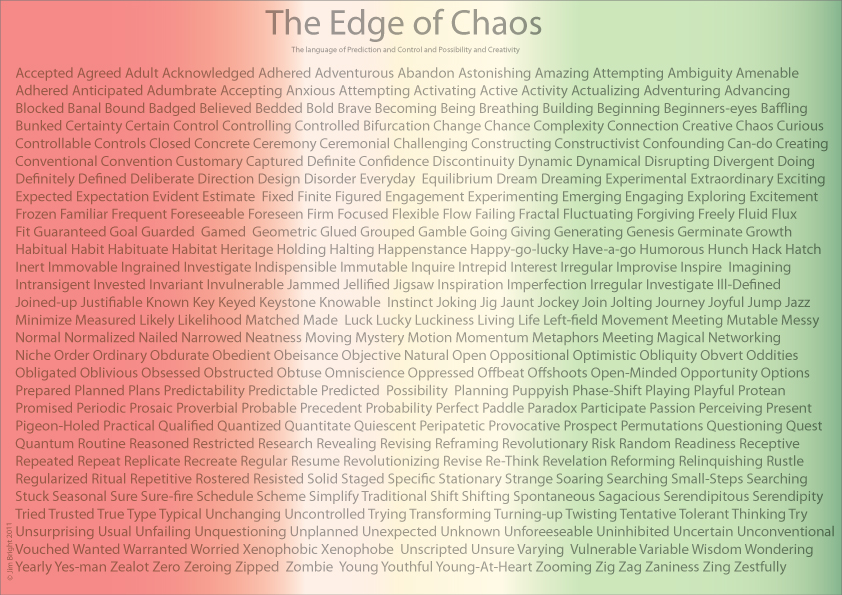
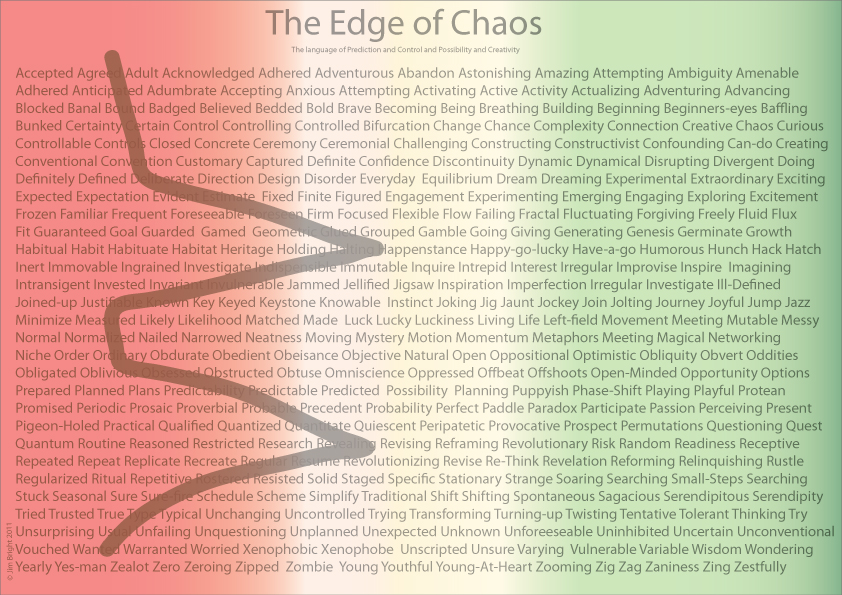
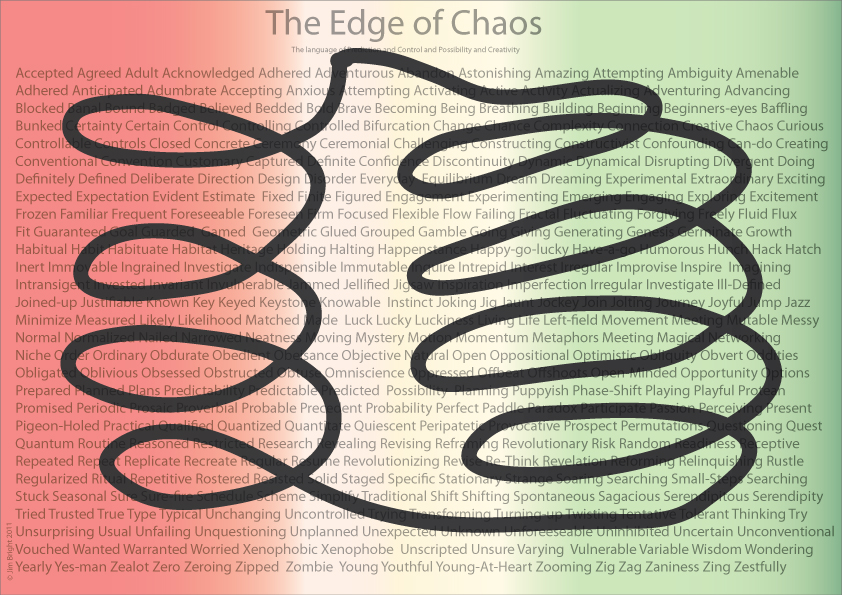
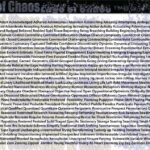
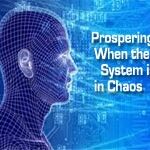
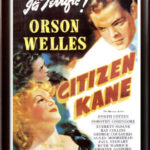

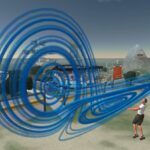


Pingback: Edge of Chaos Posters | The Factory
Pingback: Edge of Chaos Posters | The Factory